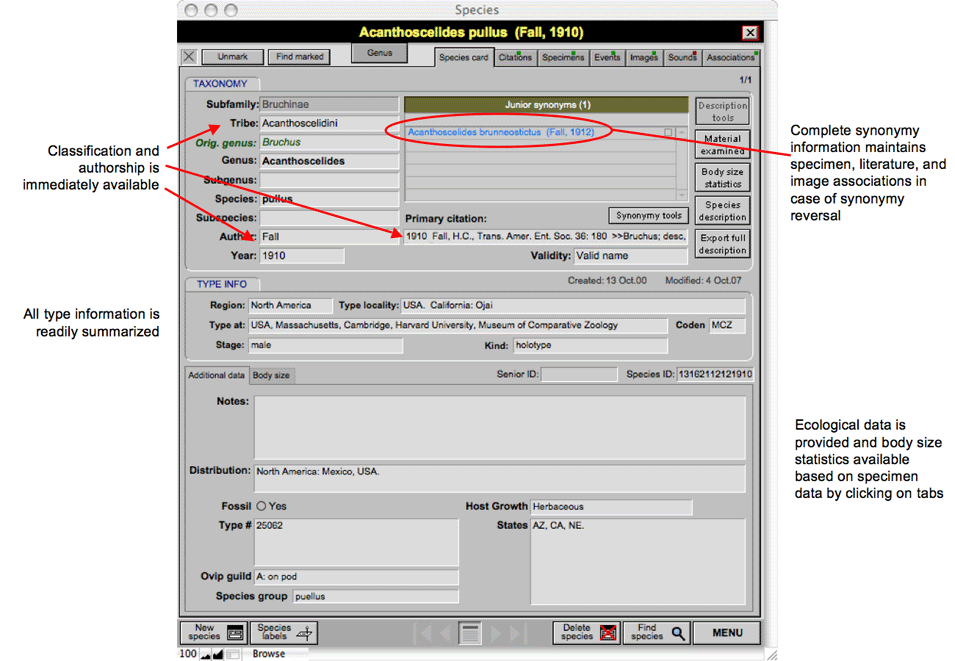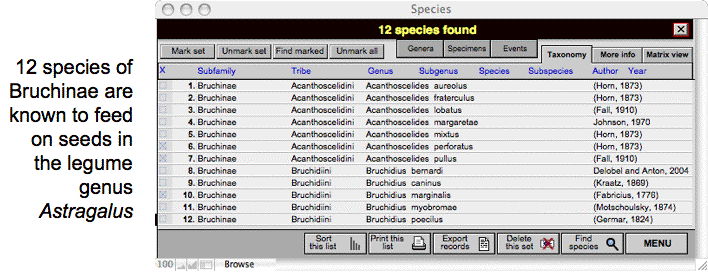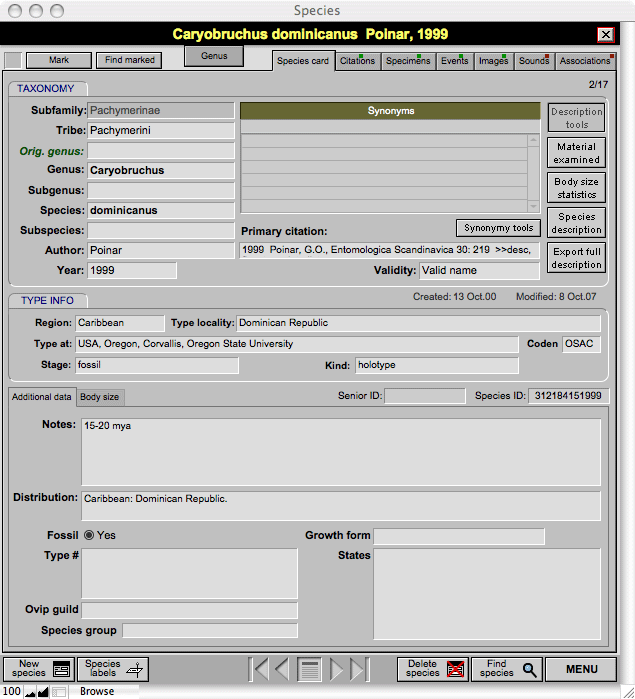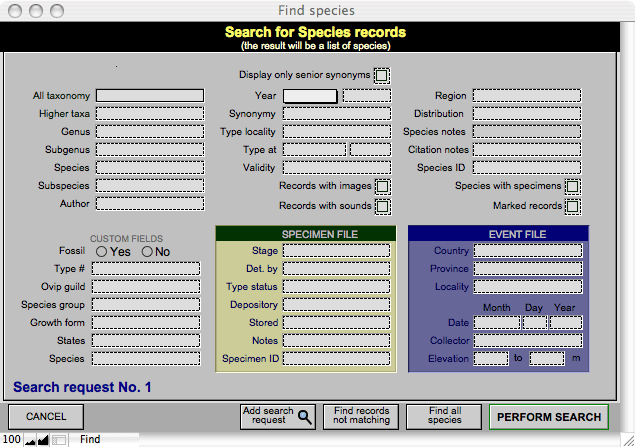BRUCHBASE Species |
||
BRUCHBASE Citations |
BRUCHBASE Hosts |
BRUCHBASE Queries |
BRUCHBASE
by Geoff Morse
SPECIES OF BRUCHINAE (Coleoptera: Chrysomelidae)
The seed beetles have traditionally been treated as a family within the Chrysomeloidea, and many taxonomists and specialists still refer to them as such and argue for this in detail (see especially "Kingsolver, J.M. 1995. On the family Bruchidae. Chrysomela 30: 3" and "Yus Ramos, R., J.M. Kingsolver, & J. Romero Nápoles. 2007. Sobre el estatus taxonómico actual de los brúquidos (Coleoptera: Bruchidae) en los Chrysomeloidea. Dugesiana 14: 1-21). This is based largely on the unique morphological characters in adults and larvae associated with spermophagy and represents an "evolutionary taxonomy" perspective. My own molecular research and the morphological and molecular research of numerous others has shown rather conclusively that the seed beetles form a monophyletic sister taxon to the Sagrinae, a subfamily of the Chrysomelidae (see especially "Reid, C.A.M. 2000. Spilopyrinae Chapuis: a new subfamily in the Chrysomelidae and its systematic placement (Coleoptera). Invertebrate Taxonomy 14:837-862" and "Farrell, B. D., and A. S. Sequeira. 2004. Evolutionary rates in the adaptive radiation of beetles on plants. Evolution 58:1984-2001"). As I ascribe to the position that taxonomy should reflect phylogeny in order to be predictive, the seed beetles must therefore be treated as a subfamily of the Chrysomelidae. There is perhaps an argument to be made that this illustrates the problems with a rank-based nomenclatural system, or that the subfamilies of the Chrysomelidae should be elevated to family status. But I will leave that argument for another day.
In BRUCHBASE, the family level is treated as Chrysomelidae (Bruchidae) in order to accommodate this disagreement. In addition, this facilitates the hierarchical classification as it is currently defined by such authorities as J.M. Kingsolver, L. Borowiec, and J. Romero Nápoles. In other words, the traditional subfamilies, tribes, and subtribes are maintained.
The species platform of BRUCHBASE is a fully searchable taxonomic database. It includes all currently valid bruchine names, including senior and junior synonyms. Note that many species of the genus Bruchus clearly belong in other genera but the combinations have not yet been published.
The database currently includes complete taxonomic information (type locality, type deposition, publication, current classification) for all 1,744 senior synonyms and all 2,433 valid bruchine names. Considerable taxonomic information is available for the 1,528 published host species. Fossil taxa are also included in the database.

BRUCHBASE is a fully searchable and relational database. This means that it is easy to search for all species in a genus, all species found in a particular geographic region, or all species that feed on a particular genus of plants. This information in summarized in a sortable list, and clicking on any species in that list will take you to the taxonomic information for that species. Full information is also available for fossil taxa.


SPECIES THAT FEED ON A PARTICULAR GENUS OF HOST PLANTS

BRUCHBASE contains complete information for all published fossil Bruchinae. At the moment this includes only 20 species. Of these, only 8 have been evaluated according to current bruchine classification and important recognized characters.

BRUCHBASE can be queried via a large array of criteria, including classification, authorship, references, geographic locality, host plants, synonymy, depository, or combinations thereof. An example below shows the standard query form. Information on individual species can also be queried through specimen information, locality information, citation information, and classification information.

All species within BRUCHBASE are incorporated into the most widely accepted classification. The classification below incorporates this. An unpublished classification with ranks subordinated one level is also provided in parentheses.
I. FAMILY Chrysomelidae/Bruchidae (Bruchinae)
A. SUBFAMILY Rhaebinae (Rhaebini)
Genus Rhaebus Fischer von Waldheim 1824
B. SUBFAMILY Pachymerinae (Pachymerini)
1. TRIBE Caryedontini (Caryedontina)
Genus Afroredon Decelle 1965
Genus Caryedon Schoenherr 1823
Genus Caryotrypes Decelle 1968
Genus Exoctenophorus Decelle 1968
Genus Mimocaryedon Decelle 1968
2. TRIBE Caryopemini (Caryopemina)
Genus Caryopemon Jekel 1855
Genus Diegobruchus Pic 1913
3. TRIBE Pachymerini (Pachyermina)
Genus Caryoborus Schoenherr 1833
Genus Caryobruchus Bridwell 1929
Genus Oligobruchus† Kingsolver 1965
Genus Pachymerus Thunberg 1805
Genus Speciomerus Nilsson 1993
Genus Mesopachymerus† Poinar 2005
C. SUBFAMILY Eubaptinae (Eubaptini)
Genus Eubaptus Lacordaire 1845
D. SUBFAMILY Amblycerinae (Amblycerini)
4. TRIBE Amblycerini (Amblycerina)
Genus Amblycerus Thunberg 1815
5. TRIBE Spermophagini (Spermophagina)
Genus Spermophagus Schoenherr 1833
Genus Zabrotes Horn 1885
E. SUBFAMILY Kytorhininae (Kytorhinini)
Genus Kytorhinus Fischer 1809
F. SUBFAMILY Bruchinae (Bruchini)
6. TRIBE Acanthoscelidini (Acanthoscelidina)
Genus Abutiloneus Bridwell 1946
Genus Acanthoscelides Schilsky 1905
Genus Algarobius Bridwell 1946
Genus Althaeus Bridwell 1946
Genus Bonaerius Bridwell 1952
Genus Caryedes Hummel 1827
Genus Cosmobruchus Bridwell 1931
Genus Ctenocolum Kingsolver & Whitehead 1974
Genus Dahlibruchus Bridwell 1931
Genus Gibbobruchus Pic 1913
Genus Lithraeus Bridwell 1952
Genus Margaritabruchus Romero & Johnson 2001
Genus Meganeltumius Romero & Johnson 2003
Genus Megasennius Whitehead & Kingsolver 1975
Genus Meibomeus Bridwell 1946
Genus Merobruchus Bridwell 1946
Genus Mimosestes Bridwell 1946
Genus Neltumius Bridwell 1946
Genus Palpibruchus Borowiec 1987
Genus Pectinibruchus Kingsolver 1967
Genus Penthobruchus Kingsolver 1973
Genus Pseudopachymerina Zacher 1952
Genus Pygiopachymerus Pic 1911
Genus Rhipibruchus Bridwell 1932
Genus Scutobruchus Kingsolver 1968
Genus Sennius Bridwell 1946
Genus Spatulobruchus Borowiec 1987
Genus Stator Bridwell 1946
Genus Stylantheus Bridwell 1946
Genus Neobruchidius Johnson & Romero 2006
7. TRIBE Bruchidiini (Bruchidiina)
Genus Acanthobruchidius Borowiec 1980
Genus Borowiecius Anton 1994
Genus Bruchidius Schilsky 1905
Genus Callosobruchus Pic 1902
Genus Conicobruchus Decelle 1951
Genus Decellebruchus Borowiec 1987
Genus Horridobruchus Borowiec 1984
Genus Kingsolverius Borowiec 1987
Genus Megabruchidius Borowiec 1984
Genus Paleoacanthoscelides Borowiec 1985
Genus Parasulcobruchus Anton 1999
Genus Pygobruchidius Pic 1951
Genus Salviabruchus Decelle 1982
Genus Specularius Bridwell 1938
Genus Sulcobruchus Chûjô 1937
Genus Tuberculobruchus Decelle 1951
8. TRIBE Bruchini (Bruchina)
Genus Bruchus Linnaeus 1767
9. TRIBE Megacerini (Megacerina)
Genus Megacerus Fåhraeus en Schoenherr 1839
Note: the separation of the tribes Acanthoscelidini and Bruchidiini is almost certainly unjustified. They are maintained here largely to indicate New World and Old World taxa.